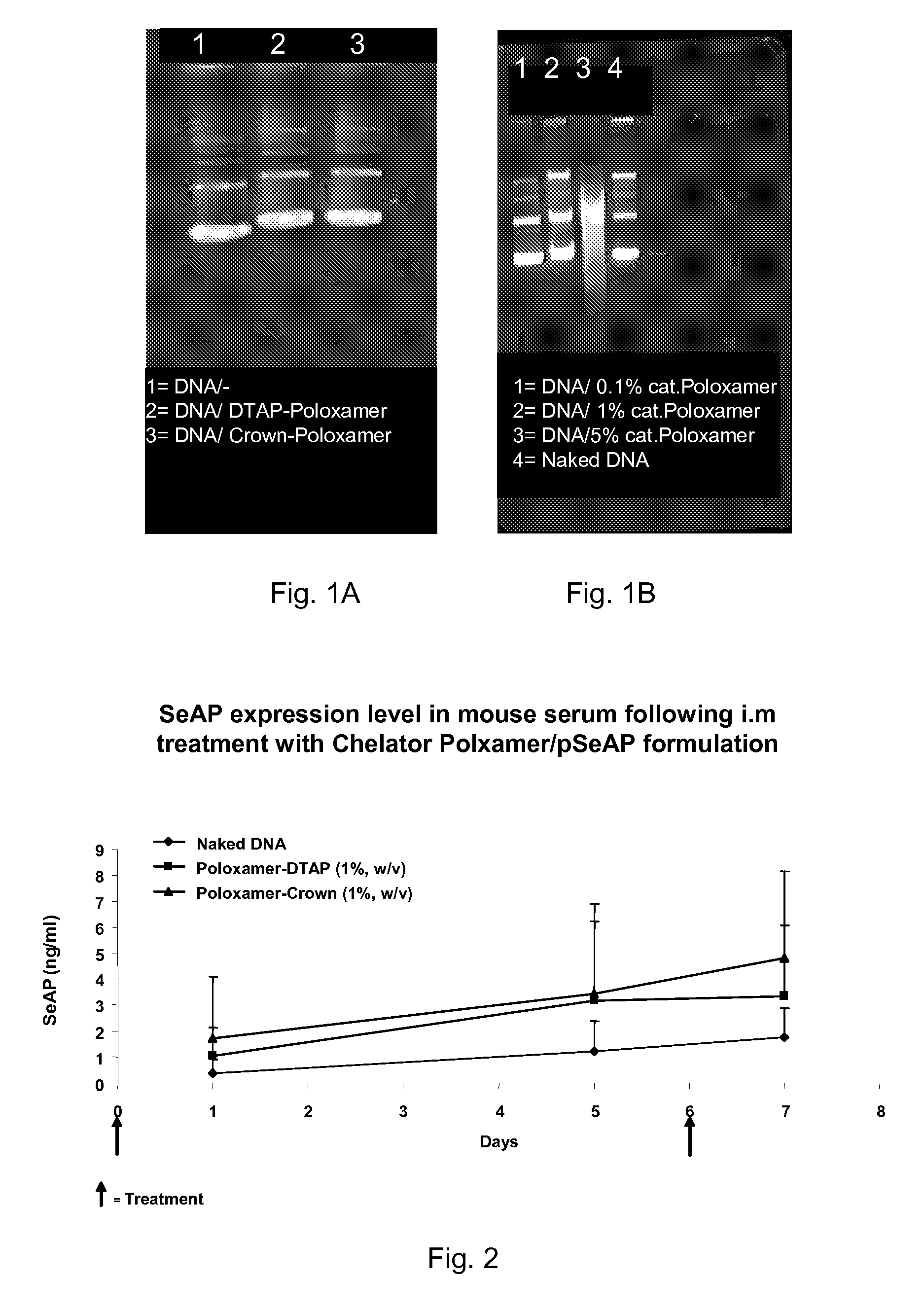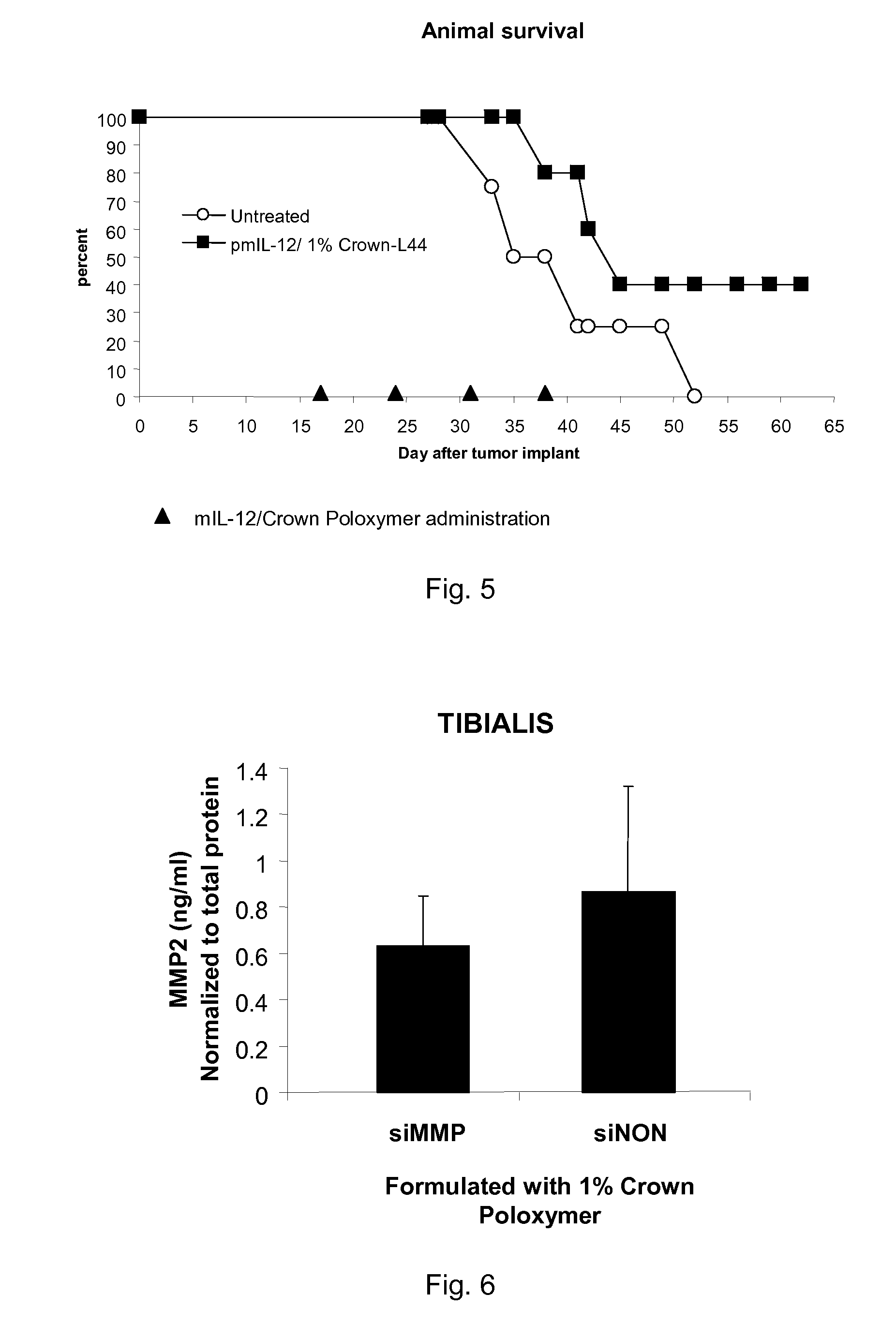Modified Poloxamers for Gene Expression and Associated Methods
a technology of gene expression and poloxamer, which is applied in the direction of pharmaceutical delivery mechanism, biochemistry apparatus and processes, and gene ingredients, etc., can solve the problems of low transfection efficiency, general instability of dna complexes with synthetic vectors, and hampered use of synthetic gene delivery vectors, so as to enhance the effect of enhancing the delivery and/or expression of nucleotide sequences
- Summary
- Abstract
- Description
- Claims
- Application Information
AI Technical Summary
Benefits of technology
Problems solved by technology
Method used
Image
Examples
example 1
Synthesis of Chelator-Linked Poloxamers: Pentetic Acid-Linked Poloxamer
[0114]
[0115]Diethylenetriaminepentaacetic acid (1 g, 2.5 mmol) was dissolved in 20 ml of dry DMSO. Dicyclohexylcarbodiimide (1.34 g, 6.5 mmol) was added, and the reaction mixture was stirred overnight. Dicyclohexylurea was removed by filtration, and poloxamer 124 (1 g, 450 μmol) was added to the filtrates. The reaction mixture was allowed to stand for 1 week; the resulting solution was treated with 30 ml of 10% aq. NaHCO3 to open the cyclic anhydrides. After 4 hrs, the mixture was further diluted with water to 120 ml and then dialyzed (membrane cutoff 1000 Da) against distilled water. The concentration of dialyzate afforded pentetic acid-poloxamer conjugate [1 g, after mechanical losses] as a glassy material.
example 2
Synthesis of Aza-Crown-Linked Poloxamer
[0116]
[0117]An aza-crown-linked poloxamer is constructed as follows. Poloxamer 124 (500 mg, 220 μmol) was dissolved in toluene (3 ml), and the resulting solution was treated with 2 ml (4 mmol) of 2M phosgene solution in toluene. After 3 hrs at room temperature, the mixture was concentrated in vacuum, the residue was re-dissolved in 3 ml toluene and concentrated again. The residue was dissolved in dry chloroform (5 ml). To this solution was added aza-18-crown-6 [1-aza-4, 7, 10, 13, 16-pentaoxacyclooctadecane (125 mg, 500 μmol) and Hunig's base (100 μl, 574 μmol). After 70 hrs the reaction mixture was concentrated in vacuum, the residue was re-dissolved in distilled water and dialyzed [membrane cutoff 1000 Da] against distilled water. Concentration of the dialyzate afforded 410 mg of the title compound.
Proton NMR (D2O): 4.20 ppm (t, CH2OC═O); 3.7-3.5 ppm [(—CH2—CH2—O—), both crown and poloxamer)]; 3.4 ppm (m, crown CH2N); 1.1 ppm (m, poloxamer —(...
example 3
Synthesis of Poloxamer Linked with Cationic Chelator
[0118]
[0119]Cationic chelator-linked poloxamers were constructed as follows: Three grams of Poloxamer 124 was placed in a 50 mL round bottomed flask and heated with stirring under high vacuum at 80° C. for 5 hours to remove water. The poloxamer was dissolved in 2 ml of toluene and 4 ml of 2M phosgene (in toluene) were added. The solution was cooled to 0° C. for 5 min, after which it was allowed to warm to room temperature. The reaction was allowed to proceed with stirring for 5 h at room temperature, after which toluene was removed to leave a clear viscous liquid. The bischloroformate-activated poloxamer was stored under argon at −20° C. until further use.
[0120]Proton NMR (D2O): 1.2 ppm (m, (—O—CH2—CH(CH3)—), 3.3 ppm (m, (—O—CH2—CH(CH3)—), 3.4 ppm (m, (—O—CH2—CH(CH3)—), 3.6 ppm (t, (—O—CH2—CH2—), 3.8 ppm (t, Cl—C(O)—O—CH2—CH2—), 4.5 ppm (t, Cl—C(O)—O—CH2—CH2—).
[0121]The two primary amines of spermidine were protected in the presenc...
PUM
| Property | Measurement | Unit |
|---|---|---|
| Size | aaaaa | aaaaa |
| Therapeutic | aaaaa | aaaaa |
| Gene expression profile | aaaaa | aaaaa |
Abstract
Description
Claims
Application Information
 Login to View More
Login to View More - R&D
- Intellectual Property
- Life Sciences
- Materials
- Tech Scout
- Unparalleled Data Quality
- Higher Quality Content
- 60% Fewer Hallucinations
Browse by: Latest US Patents, China's latest patents, Technical Efficacy Thesaurus, Application Domain, Technology Topic, Popular Technical Reports.
© 2025 PatSnap. All rights reserved.Legal|Privacy policy|Modern Slavery Act Transparency Statement|Sitemap|About US| Contact US: help@patsnap.com



